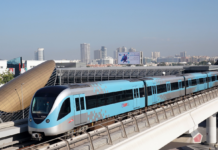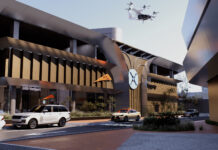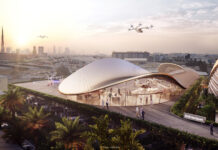Source: www.ameinfo.com
The UAE is building the Gulf’s first mainline railway network at a cost of almost $11bn. Graeme Overall, head of business development at the project’s master developer and operator, Etihad Rail, explains how the network will cement the UAE’s position as the region’s most high-tech trade and industry hub.
 In April Etihad Rail, the master developer and operator of the UAE‘s first mainline railway network, said that it will award its first contract before the end of August, and hopes to complete the $10.9bn project by 2018. According to Etihad Rail – which is 70% owned by the Abu Dhabi government and 30% by the UAE federal government – three contracts are already out in the market for bid for the first phase of the project, a 264km-long line from Shah to Ruwais.
In April Etihad Rail, the master developer and operator of the UAE‘s first mainline railway network, said that it will award its first contract before the end of August, and hopes to complete the $10.9bn project by 2018. According to Etihad Rail – which is 70% owned by the Abu Dhabi government and 30% by the UAE federal government – three contracts are already out in the market for bid for the first phase of the project, a 264km-long line from Shah to Ruwais.
The UAE‘s national rail scheme is designed primarily to improve cargo links across the seven emirates. While there are plans to run passenger trains eventually, the immediate priority is to lay trade routes that will cement the UAE‘s enviable position as the Gulf’s most prominent trade hub.
“The railway will make a significant contribution to the economic and social development of the UAE,” says Graeme Overall, head of business development at Etihad Rail. “It will connect the key areas of trade and commerce in the UAE, linking heavy industry, the ports, and the main centres of population. And as the population grows we will have a bigger role to play; indeed, we will be facilitating that growth.”
UAE rail network to run 1,200km
The network will eventually run for 1,200km across the country, threading its way through all seven emirates and even linking to proposed regional lines, to Saudi Arabia via Ghweifat in the west and Oman via Al Ain in the east. The Shah-Ruwais line will be in operation as early as 2013 and will be used to transport wagons of granulated sulphur for export. When complete, the UAE-wide network will transport some 50 million tonnes of freight and 16 million passengers over the next 20 to 30 years, on freight trains running at speeds of up to 120kph, and passenger trains at speeds of up to 200kph.
“When you include Etihad Rail with Dubai’s existing transport and logistics infrastructure, you get a set-up that is unrivalled in the GCC region,” says H.E. Hamad Buamim, director general of the Dubai Chamber of Commerce and Industry (DCCI). “We currently have the ability to transport goods by air, sea and road, and the addition of rail will help further cement the UAE‘s position as the Gulf’s leading trade hub.”
“There are major flows of freight within the country, and this is our first priority, as well as the need which is easiest to cater for,” adds Overall at Etihad Rail. “There are very large quantities of materials being moved around the country now, and they can be moved by rail very straightforwardly, without the need to penetrate urban areas.”
Quality of air expected to improve
UAE residents in those urban areas might also find it a little easier to breathe once the railway is up and running. The network is expected to make an immense contribution to improving the quality of the air in the country, cutting the number of heavy goods vehicles, which dominate UAE roads today.
“Just one train can handle the freight of around 300 trucks, while generating about 20% of the fumes that those trucks would emit,” says Overall.
“At the same time we are making sure that we are ‘good neighbours’ wherever we go, and are minimising the impact of the railway itself on the areas that we pass through. In the construction phase we are acting responsibly to reduce the impact as far as we can, and we have to meet stringent requirement in terms of managing downwards our environmental impact.”
The Economist Intelligence Unit forecasts that the UAE‘s non-oil exports will rise by around a third over the next five years, to $294bn by 2016. Much of this increase will come from intra-Arab trade, and the new rail network will certainly be expected to do its part to speed transaction flows across the Middle East.
“Etihad Rail will benefit Dubai’s trade, transport and logistics sectors when it becomes operational,” says Buamim at the DCCI. “Moreover, through it, traders will have a new option for transporting goods across the UAE, Saudi Arabia and Oman.”
GCC wide project expected by 2017
The six Gulf Cooperation Council (GCC) members plan to spend more than $100bn on a rail project linking them up by 2017, with long-range plans to extend the high-speed network as far as Yemen in the south of the Arabian Peninsula.
“What we’re doing forms part of a grander plan to build the GCC railway, which will run the length of the Gulf,” confirms Overall at Etihad Rail. “It’s important to us and we expect our business to be all the more robust and successful once those connections are in place, but I must emphasise that we have a very strong case for building our rail network even without those connections. As a standalone rail network, it’s a pretty solid proposition.”
Nevertheless, there are significant engineering challenges to overcome, not least the extreme heat conditions and the abrasive qualities of desert sand. “We’re building on nearly 200 years of development and experience in what is now a very sophisticated, reliable and effective form of transport,” says Overall. “At the same time, we have some environmental challenges here that will have to be carefully managed, whether it they are to do with temperature, topography, drought conditions, or anything else.
“There are many challenges but there are no insurmountable problems,” he continues. “We are putting a railway into territory which hitherto hasn’t had one, so we are working very hard to help people understand the new opportunities that the railway offers, and so far we’ve had a very positive response. People are unfamiliar with the railway and don’t always understand what it will do for them, but they’re very keen to find out and very keen to make the best of it when it comes.”


















